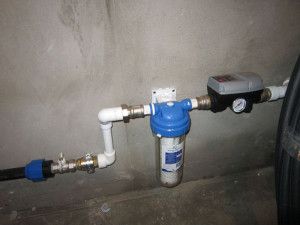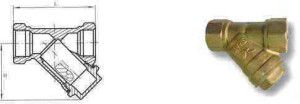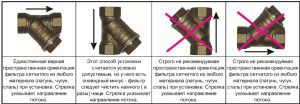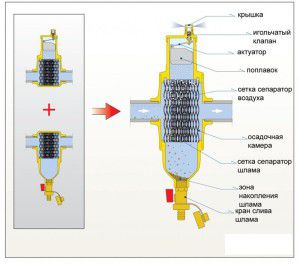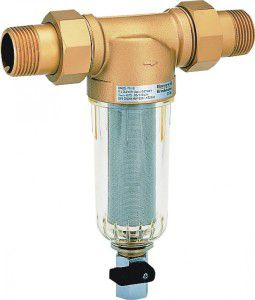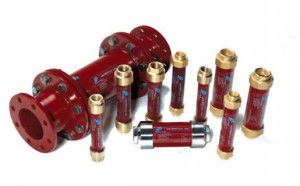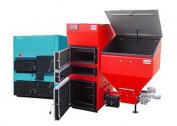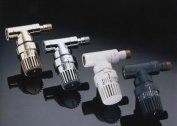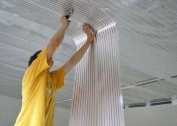Differences in temperature and pressure in the heating system are the main factors in the rusting of pipes and steel elements. This leads to clogging of the water, which worsens the condition of the radiators, boiler heat exchanger, etc. To avoid this, filters for the heating system are needed: mud, magnetic, sedimentation tanks and similar components.
The relevance of installing heating filters
What else is the cause of the change in the composition of the coolant? Firstly, the connection of the make-up unit to the central water supply. In this case, mud filters for heating will trap most of the impurities.
In addition, there is another factor in the appearance of foreign elements in water. Even in a carefully distilled coolant there is a certain% of mineral additives. During an increase in temperature, it precipitates, forming limescale on the pipes. With sufficiently intense circulation, part of it enters the water in the form of particles of a sufficiently large fraction. The installed filter for the heating system will delay them, thereby leaving the system parameters at the proper level.
What filter elements should an autonomous heating system consist of?
- Preliminary rough cleaning. It is mandatory to install when connected to a central water supply to recharge the system. The optimal model is a filter sedimentation tank in heating, into the flask of which all foreign components are collected;
- Fine cleaning. With its help, it is possible to delay the advancement of small particles whose size is less than 100 microns;
- Additional magnetic filters for heating. On their walls made of a ferrimagnetic alloy, metallized particles remain - rust, chipped pipes, etc.
The selection of the most suitable filter models for heating must begin with a thorough analysis of each type.
Installing a dirt filter is mandatory, since even in an autonomous system with a well-treated coolant, rust from pipes and the boiler heat exchanger can get into the water.
Coarse water treatment with heating filters
The main component of the system for trapping sufficiently large contaminants is a coarse filter for heating. Depending on the scheme and type of heating, it is mandatory to install it in several areas. There are several models of coarse filters that differ not only constructively, but also by the material of manufacture.
Dirt filter
The simplest design is an element installed on a specific part of the system. It contains a mesh trap located in the branch pipe of the structure.
It is mounted on the connection to the central heating system. For stand-alone circuits, its installation is mandatory at the branch points, on the return pipe before it is connected to the boiler and on the bypass.
Depending on the design and fabrication material, the dirt filter for the heating system can be of the following types:
- By connection method - threaded, welding or flange;
- By location - vertical or horizontal.
The most common brass models are designed for a maximum temperature of up to 150 ° C at a pressure of more than 2.5 MPa. Steel types have the same indicators, but they are more susceptible to corrosion. For plastic piping, there is a polymer filter for the heating system.However, their temperature mode of operation is much lower than for the others - the maximum temperature of the coolant is at + 90 ° C.
In order for the filter for heating to properly perform its function, proper installation is necessary. On the case of the device the direction of movement of the coolant must be indicated. If you install it the other way around, then in addition to the lack of filtration, additional hydraulic resistance will arise.
It is also necessary to periodically clean the net from accumulated dirt and debris. To do this, there is a screw cap on the outlet pipe that can be removed. But first you should block the movement of the coolant in this section of the pipeline.
A filter with a mesh for the heating system will protect the circulation pump from getting into the debris blades. If it is not installed, then the likelihood of the impeller and engine malfunctioning increases significantly.
Filter sump
This is an improved model that allows for a long time not to carry out maintenance work. The specific design of the mud filter for heating with a sump is the presence of a bulb located at the bottom. Foreign components, lingering on a metal mesh under the action of gravity, sink to its bottom. The flask is made of heat-resistant transparent plastic, which allows you to visually control the degree of contamination of the element.
Often, to reduce the oxygen content in water, a separator is installed in one housing with a filter for the heating system. When the coolant passes through the filter, air is released, which is concentrated in the upper part of the structure. When a certain pressure value is reached, the drain valve opens.
The advantages and features of installing a similar model of the coarse filter for heating are as follows:
- The ability to visually control the degree of filling of the flask. To drain contaminated liquid, a tap is installed from below;
- Reducing the air content in the water minimizes the corrosion processes on the steel elements of the system;
- Installation is carried out almost immediately after the heating boiler. It is in this part of the pipeline that the temperature and pressure of the coolant are maximum, which contributes to the better operation of the separator.
But you need to consider the big difference in cost. The average price of a dirt filter for a heating system is about 140 rubles. At the same time, a combined model with an air separator will cost much more - up to 7 thousand rubles.
Be sure to check the material of manufacture of the flask at the filter sump. This should be a heat-resistant plastic that does not lose its shape under the influence of high temperature.
Fine filter
In autonomous systems, it is preferable to install an additional fine filter. It differs from the above types in that the cassette is used as the main component. Depending on the design, it can be either cylindrical or square. The latter is very rare, since the production of such species is associated with certain difficulties.
When choosing, you need to pay attention that the filter model for the heating system is designed for sufficiently high temperatures. If you install an analog for the water supply - the housing or filter element may be damaged by exposure to hot water. Another factor is the throughput - it should not be less than the calculated pressure in the system. Usually this is 7.2 m³ / hour.
What other parameters are important for a fine filter designed for installation in a heating system?
- Wall mount option. This is important for plastic pipelines in which an increase in load due to filling the flask with water is not allowed;
- Filter material. For heating, it is best to purchase mesh models made of metal;
- Maximum values of temperature and pressure.
How relevant is the installation of filters for fine heating. If a preliminary treatment of the coolant has been carried out, you can do without them. In addition, when using antifreeze, the installation of a fine filter is prohibited. The density of the coolant will be much higher than that of water. This will make it difficult to flow through the filter element. The average cost of this component for heating is from 2.2 to 4 thousand rubles.
A small increase in the budget for the arrangement or modernization of heating with filters (mud, magnetic, sedimentation tanks) will reduce the likelihood of an emergency.
Magnetic models of heating filters
Initially, the development of filters for a heating system with a magnet was designed only for water supply. However, their unique performance has contributed to their use in heating.
The design consists of two permanent magnets with different poles located opposite each other. Metal elements in water are small, therefore, falling into the field of action of a magnetic filter for heating, remain on its surface. But how then to clean it? In fact, even after 10 years of operation, the level of wall contamination will be extremely low. This will not affect the throughput on this part of the system.
In addition to magnets, dirt heating filters may be included. But the main selection criterion is the design. It can be of two types:
- Removable. Represents two plates installed on a heating pipe. It is characterized by simple installation and the ability to quickly replace;
- Fixed. This is a pipe made of ferrimagnetic alloys. In contrast to the above model, monolithic magnetic filters for heating systems have a longer service life, and are also characterized by high magnetic field.
The cost depends on the model, and in particular - its type and size of the magnetic part. The simplest filter with magnets for heating costs about 600 rubles. But a design with optimal operational parameters will cost 4-5 thousand rubles.
Is it worth it to install all the types described or is it enough to do with a coarse filter in heating? Much determines the preliminary preparation of the coolant and the material for the manufacture of pipes. For an autonomous system with plastic lines filled with distilled water, a filter with a sump is sufficient. When connected to central heating, it is best to install all three types, since in most cases water contains a large amount of impurities and polluting components.
Additional nuances of installing and selecting a coarse filter can be found in the video presented.
